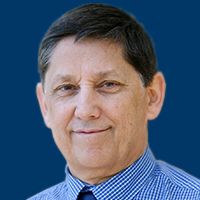Strategizing Effective Ways to Overcome TKI Resistance in ALK+ NSCLC
Vincent Lam, MD, describes frontline indications for this patient population, as well as strategies that can be utilized to overcome TKI resistance in later lines of therapy.
Vincent Lam, MD

ALK-targeted Tyrosine kinase inhibitors (TKIs) have proven efficacy in the frontline treatment of patients with advanced, ALK-positive non–small cell lung cancer (NSCLC), but several factors must be taken into consideration when determining later-line approaches to combat the complex resistance mechanisms that develop, Vincent Lam, MD, said in a presentation during the 18th Annual Winter Lung Cancer Conference, a program hosted by the Physicians Education Resource®, LCC.1
“The acquired resistance landscape upon progression with a second-generation ALK TKI is quite diverse, and we’re still learning about new bypass mechanisms and second drivers,” said Lam, an assistant professor of oncology and director of the Esophageal Cancer Research Program at Johns Hopkins Medicine Sidney Kimmel Comprehensive Cancer Center, during the presentation. “The overall [theory] right now is to stay on the current TKI as long as possible, [implement] local ablative therapy for oligoprogression or dose escalation for alectinib [Alecensa] in central nervous system [CNS]–only progression, and, if available, utilize repeat molecular profiling to help inform our next treatment option.”
In his presentation during the meeting, Lam further described frontline indications for this patient population, as well as strategies that can be utilized to overcome TKI resistance in later lines of therapy.
Exploring the Frontline Treatment Landscape
Updated results from the phase 3 ALEX study (NCT02075840), which examined the use of alectinib vs crizotinib (Xalkori) in patients with previously untreated, ALK-positive NSCLC, indicated that those who received alectinib experienced a 5-year survival rate of 62.5%. The median progression-free survival (PFS) was 34.8 months in the alectinib arm compared with 10.9 months in the crizotinib arm.2
Based on findings from ALEX, in November 2017, alectinib was approved by the FDA for the frontline treatment of patients with ALK-mutated NSCLC.3 Although other agents have also been approved for use in the first-line setting, such as brigatinib (Alunbrig), which was approved by the FDA in May 2020 and ceritinib (Zykadia), which was approved in May 2017,4,5 alectinib is the most commonly used option, according to Lam.
Another agent that has emerged in the frontline setting is lorlatinib (Lorbrena). Results from the phase 3 CROWN study (NCT03052608), which examined the use of lorlatinib vs crizotinib in patients with advanced ALK-positive NSCLC, showed a significant improvement in PFS with lorlatinib. The median PFS had not been reached (NR) in those who received lorlatinib (95% CI, NR-NR) vs 9.3 months (95% CI, 7.6-11.1) in the crizotinib arm (HR, 0.28; 95% CI, 0.19-0.41; P <.001). Additionally, lorlatinib demonstrated improved survival without CNS progression over crizotinib (HR, 0.07; 95% CI, 0.03-0.17).
However, Lam noted that toxicity is an important consideration when determining whether a patient should receive lorlatinib. Adverse effects such as hypercholesterolemia (70%), hypertriglyceridemia (64%), weight increase (38%), peripheral neuropathy (34%), and cognitive effects (21%) have all been associated with lorlatinib.6
“Lorlatinib is undoubtedly coming to the firstline landscape in the future, and we’ll have to see what acquired resistance looks like in this new context,” Lam said.
Forming Effective Strategies to Combat TKI Resistance
If possible, it is ideal to keep patients on their current TKI for as long as possible, according to Lam. Results of a retrospective analysis indicated that in cases of oligoprogression, local ablative therapy, such as radiation and/or surgery, yields an additional 6 months of disease control. Also, for patients on alectinib with CNS-only progression, escalating treatment with alectinib to 900 mg twice daily may be useful.7
When selecting therapies for the second line of treatment and beyond, options include starting with the thirdgeneration TKI lorlatinib if it has not been used already. Treatment with a second-generation TKI such as brigatinib could also represent an effective strategy for some patients, according to Lam. Other options in the second-line treatment and beyond include targeted agents for genes that bypass resistance pathways, such as MET, EGFR, or BRAF, and chemotherapy-based regimens.
According to Lam, several factors need to be considered when choosing among these regimens.
“It’s helpful to review the general paradigm of acquired resistance and ALK,” Lam said. “About 50% of resistance to ALK TKIs is due to acquired mutations in the ALK gene that impair the efficacy of the current ALK TKI. There is a broad spectrum of these mutations, the most common being the solvent front mutation [ALK] G1202R; this is considered to be an ALK-dependent acquired resistance because the tumor is primarily still signaling through the ALK receptor tyrosine kinase. Next-generation TKIs should be effective.”
Other acquired resistance is ALK independent and involves second driver alterations, histologic transformation (such as small cell transformation), or other bypass mechanisms that mediate tumor proliferation despite adequate ALK inhibition. Merely switching to a more potent ALK TKI likely will not overcome this resistance, said Lam.
The Importance of Repeat Molecular Profiling
Moreover, the use of molecular profiling should be employed to inform decisions in later lines of treatment; this can be done both through standard tumor tissue biopsies and plasma-based assays, although Lam noted that some limitations exist with liquid biopsies.
“If genetic testing reveals a G1202R mutation, it’s best to pursue treatment with lorlatinib, whereas someone with a L1196M mutation should be treated with brigatinib,” Lam explained. Additionally, patients with MET amplifications and fusions should be treated with crizotinib or capmatinib (Tabrecta), whereas those with EGFR and BRAF V600E mutations and NRG1 and RET fusions should be approached with a targeted agent for second driver mutations, Lam added.
Repeat molecular profiling may be able to help inform options following disease progression. The National Cancer Institute is supporting a large clinical trial effort, the ALK Master Protocol (NCT03737994), to determine the effectiveness of combinations of different biomarker/ ALK inhibitors in improving clinical outcomes for patients with stage IV ALK-positive NSCLC.
The ALK Master Protocol is open across the United States, enrolling patients with ALK-positive, stage IV NSCLC who have progressed on a second-generation TKI. To be eligible for enrollment, patients must have measurable disease and an ECOG performance status of 0 to 2. Patients could have received prior crizotinib but not lorlatinib. Notably, patients with stable, untreated brain metastases are permitted to enroll.
Patients will be stratified based on ALK mutation to one of several different TKIs or chemotherapy. The primary objectives of the study include objective response rate (ORR) to the ALK TKI based on mutation, ORR to the chemotherapy-based regimen for patients with non–ALK-mutant disease, and ORR to crizotinib based on ALK L1198F or MET amplifications. Secondary end points include PFS, duration of response, overall survival (OS), and CNS ORR, as well as safety and tolerability.
Examining Efficacy of Second-Line Agents
Although lorlatinib has demonstrated benefit in patients with ALK resistance mutations, the agent has been shown to elicit less efficacy in patients without an ALK mutation. Following treatment with a second-generation TKI, patients with no mutations had an ORR of 27% (95% CI, 18%-38%) with the agent compared with 69% (95% CI, 49%-85%) in patients with at least 1 mutation. Additionally, the median PFS achieved with lorlatinib was essentially halved in patients without ALK mutations, going from 11.0 months to 5.4 months (HR, 0.47).8
“Notably, only about half of the patients in this study had a fresh biopsy specimen obtained for tissue biopsy profiling prior to starting lorlatinib,” said Lam. “The actual number of responders who actually had no ALK resistance mutation may be lower than what was detected in the study.”
Available data also support the use of brigatinib following treatment with a second-generation TKI. Preliminary results from the phase 2 ATOMIC study (NCT02706626) showed that brigatinib elicited an ORR of 40% and a median PFS of 7 months in patients who were primarily previously treated with alectinib; the median OS had not yet been reached.9 Moreover, according to data from the BRIGALK expanded access study (NCT02784158), which primarily enrolled patients who were previously treated with ceritinib, brigatinib elicited an ORR of 50%, a median PFS of 6.6 months, and a median OS of 17.2 months.10
Lastly, platinum-based chemotherapy and pemetrexed are the most commonly used chemotherapies in this patient population, noted Lam. Patients with ALK-positive disease are known to demonstrate increased sensitivity to pemetrexed.
“That being said, the IMpower150 chemotherapy and immunotherapy regimen with carboplatin, paclitaxel, bevacizumab [Avastin], and atezolizumab [Tecentriq] is another approved chemotherapy-based option,” concluded Lam, “as that study did show PFS benefit compared with chemotherapy and bevacizumab alone for the EGFR/ ALK [patient] subgroup[s].”
However, Lam cautions that patients with EGFR mutations may be largely driving the clinical benefit seen there, as patients with ALK mutations were only a small percentage of that combined subgroup.
References
- Lam V. Overcoming resistance to ALK TKIs. Presented at: 18th Annual Winter Lung Cancer Conference; February 5-7, 2021; Virtual.
- Peters S, Mok TSK, Gadgeel SM, et al. Updated overall survival (OS) and safety data from the randomized, phase III ALEX study of alectinib (ALC) versus crizotinib (CRZ) in untreated advanced ALK+ NSCLC. J Clin Oncol. 2020;38(suppl 15):9518. doi:10.1200/JCO.2020.38.15_suppl.9518
- FDA approves Genentech’s Alecensa (alectinib) as first-line treatment for people with specific type of lung cancer. News release. Genetech. November 6, 2017. Accessed February 8, 2021. http://bit.ly/2zmLda7
- U.S. FDA approves Takeda’s ALUNBRIG (brigatinib) as a first-line treatment option for patients diagnosed with rare and serious form of lung cancer. News release. Takeda. May 22, 2020. Accessed February 8, 2021. https://bit.ly/3gc8qk5
- FDA broadens ceritinib indication to previously untreated ALK-positive metastatic NSCLC. News release. FDA. May 26, 2017. Accessed February 8, 2021. http://bit.ly/2Oi0dBA
- Solomon B, Bauer TM, De Marinis F, et al. Lorlatinib vs crizotinib in the first-line treatment of patients (pts) with advanced ALK-positive non-small cell lung cancer (NSCLC): results of the phase III CROWN study. Ann Oncol. 2020;31(suppl 4):S1180-S1181. doi:10.1016/annonc.2020.08.2282
- Weickhardt AJ, Scheier B, Burke JM, et al. Local ablative therapy of oligoprogressive disease prolongs disease control by tyrosine kinase inhibitors in oncogene-addicted non-small-cell lung cancer. J Thorac Oncol. 2012;7(12):1807-1814. doi:10.1097/JTO.0b013e3182745948
- Shaw AT, Solomon BJ, Besse B, et al. ALK resistance mutations and efficacy of lorlatinib in advanced anaplastic lymphoma kinase-positive non–small-cell lung cancer. J Clin Oncol. 2019;37(16):1370-1379. doi:10.1200/JCO.18.02236
- Stinchcombe T, Doebele RC, Wang XF, et al. Preliminary results of single arm phase 2 trial of brigatinib in patients (pts) with progression disease (PD) after next-generation (NG) anaplastic lymphoma kinase (ALK) tyrosine kinase inhibitors (TKIs) in ALK+ non-small cell lung cancer (NSCLC). J Clin Oncol. 2019;37(suppl 15):9027. doi:10.1200/JCO.2019.37.15_suppl.9027
- Descourt R, Perol M, Rousseau-Bussac G, et al. Brigatinib in patients with ALK-positive advanced non-small-cell lung cancer pretreated with sequential ALK inhibitors: A multicentric real-world study (BRIGALK study). Lung Cancer. 2019;136:109-114. doi:10.1016/j.lungcan.2019.08.010



